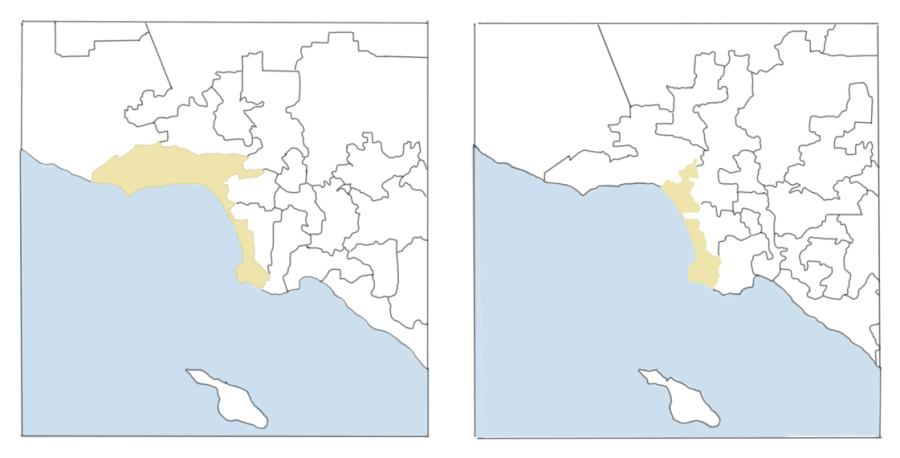Redistricting Redraws California Lines
Left: The previous congressional map and CA-33 Right: The new congressional map and CA-36 (Graphics by Alycen Kim)
On the night of Dec. 20, the independent 14-person California Redistricting Commission unanimously voted to approve final congressional maps a week ahead of the Dec. 27 deadline.
The approval, which comes after a fraught 2020 census season that saw accusations of politicization and undercounting due to the pandemic, is set to redraw congressional districts for the next decade.
As a result of 2020 census results showing a slowing of growth in the Golden State, California lost a single congressional district bringing the state’s total to 52, down from 53.
Like redistricting in any state and despite the apolitical nature of California’s redistricting process, the drawing of new lines comes charged with potential changes and controversies for both the state’s inhabitants and those who represent them.
Locally, the district formerly known as CA-33 (now CA-36), which encompassed the Palos Verdes Peninsula and most of the South Bay has changed slightly since the 2010 redistricting. While the 33rd previously incorporated parts of San Pedro, the border of CA-36 now cuts off at the line dividing eastern Rancho Palos Verdes from western San Pedro (along Western Ave.), putting some PVHS students living in San Pedro under CA-44 instead.
In addition, parts of the 36th in Wilmington have been reallocated while parts of West L.A. including Beverly Hills were added. CA-36 also now only extends as far north as Wilshire while previously encompassing parts of the coast past Point Dume.
Despite these changes, the political leanings of CA-36 remain almost the same, moving from 37 points in favor of Democrats to 40. Rep. Ted Lieu (D) is expected to once again lead the ballot in the upcoming 2022 midterms.
Further south, newly drawn lines have caused greater upheavals in Orange County.
Rep. Michelle Steel (R-CA-48), who recently unseated former Rep. Harley Rouda (D) in the 2020 election, finds herself in a district now encompassing the much bluer Irvine (once part of CA-45).
That district is currently represented by Rep. Katie Porter (D), a nationally known and popular congresswoman first elected in 2018. Porter recently announced that during this upcoming election cycle, she will run in CA-47, a district that holds much of Steel’s previous territory, due to that district now encompassing her home in Irvine.
This announcement led Rouda (who previously planned to challenge Steel in the same district) to concede to Porter and allow her to run unopposed in the upcoming primaries. Steel, burdened with the likelihood of defeat against a popular Porter in an already much bluer district, released her decision to move north to the CA-45.
Despite these changes, the balance of power in Southern California seemingly remains similar to before. However, only the 2022 midterms will determine if that stays true.

This is Aidan's third year writing for The Point. Last year he served as news editor for the paper, focusing on bringing big stories to PVHS. Aidan enjoys...
